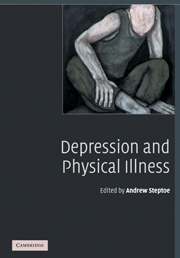
-
Select format
-
- Publisher:
- Cambridge University Press
- Publication date:
- 17 September 2009
- 26 October 2006
- ISBN:
- 9780511544293
- 9780521603607
- Dimensions:
- Weight & Pages:
- Dimensions:
- (247 x 174 mm)
- Weight & Pages:
- 0.872kg, 434 Pages
- Subjects:
- Psychiatry and Clinical Psychology, Medicine, Psychiatry
You may already have access via personal or institutional login- Subjects:
- Psychiatry and Clinical Psychology, Medicine, Psychiatry
Book description
Depression and physical illness are intimately related. Depressed mood is thought to contribute to the development and progression of some illnesses, while physical illness can in turn increase the risk of depression. This book provides a critical overview of the evidence linking depression with several major health conditions, including coronary heart disease, diabetes, cancer, chronic pain, disability, chronic fatigue and obesity. It also explores the biological and behavioural processes underlying the association, discussing the role of neuroendocrine, immunological and inflammatory pathways, and the relationship between depression and health behaviours such as smoking, physical activity and adherence to medical advice. It combines a thorough analysis of the clinical, biological and epidemiological data with guidance to health professionals and patients on how to manage depression in people suffering from physical illness, pointing the way to an integrated approach to health care.
Reviews
'I recommend this book highly to all mental healthcare professionals … I would recommend this book to other medical specialists - on checking the contents of the latest editions of several prominent textbooks of medicine, I could find no reference to the role of depression despite the overwhelming evidence presented in Depression and Physical Illness.'
Source: British Journal of Psychiatry
'…a useful resource for those interested in depression.'
Source: Journal of Psychosomatic Research
'… this book is well worth considering. It gives helpful guidance to health professionals of all kinds on improving the health care of patients suffering from a wide range of disorders.'
Source: Journal of Mental Health
Contents
Metrics
Full text views
Full text views help Loading metrics...
Loading metrics...
* Views captured on Cambridge Core between #date#. This data will be updated every 24 hours.
Usage data cannot currently be displayed.
Accessibility standard: Unknown
Why this information is here
This section outlines the accessibility features of this content - including support for screen readers, full keyboard navigation and high-contrast display options. This may not be relevant for you.
Accessibility Information
Accessibility compliance for the PDF of this book is currently unknown and may be updated in the future.


